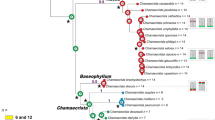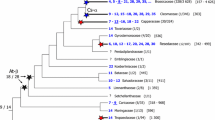Abstract
The dalbergioids, one of the largest clades among legumes, present significant karyotype diversity. Previous studies suggested different base chromosome numbers, hampering the understanding of karyotype evolution in dalbergioid legumes. In this study, we integrated chromosome numbers from the literature with phylogenetic data and new cytogenetic data for six species aiming to clarify the paths of karyotype evolution. We could confirm the base chromosome number of dalbergioid legumes as x = 10, which was constant for the three dalbergioid clades, namely Adesmia, Dalbergia, and Pterocarpus. However, we found alternative base chromosome numbers for some genera, which illustrate the two main mechanisms of chromosome changes found in dalbergioids: polyploidy and dysploidy. Considering the first diverging lineages in the phylogeny, polyploidy and dysploidy could be detected in seven and three nodes, respectively, with two out of the three dysploidy events associated with polyploidy. Nevertheless, considering the chromosome changes within species, the descendent dysploidy was the most common event in dalbergioid legumes. Such a high frequency of dysploidy highlights the importance of studying multiple populations from each species. In addition, the chromosome banding revealed DAPI+ bands, which is not commonly found in plants, as a possible chromosome marker for Stylosanthes. The chromosome banding analysis has taxonomic potential and could be explored in future studies to better understand the complex taxonomic groups inside dalbergioid legumes.



Similar content being viewed by others
References
Akaike H (1974) A new look at the statistical model identification. IEEE Trans Autom Control 19:716–723
Arrighi JF, Chaintreuil C, Cartieaux F, Cardi C, Rodier-Goud M, Brown SC, Boursot M, D’Hont A, Dreyfus B, Giraud E (2014) Radiation of the Nod-independent Aeschynomene relies on multiple allopolyploid speciation events. New Phytol 201:1457–1468. https://doi.org/10.1111/nph.12594
Auquier P, Renard R (1975) Nombres chromosomiques de quelques angiospermes du Rwanda, Burundi et Kivu (Zaïre)—I. Bull Jard Bot Natl Belg 45:421–445
Bairiganjan GC, Patnaik SN (1989) Chromosomal evolution in Fabaceae. Cytologia 54:51–64
Bandel G (1974) Chromosome numbers and evolution in the Leguminosae. Caryologia 27:17–32
Barker MS, Arrigo N, Baniaga AE, Li Z, Levin DA (2016) On the relative abundance of autopolyploids and allopolyploids. New Phytol 210:391–398. https://doi.org/10.1111/nph.13698
Bertioli DJ, Seijo G, Freitas FO, Valls JF, Leal-Bertioli SC, Moretzsohn MC (2011) An overview of peanut and its wild relatives. Plant Genetic Res 9(01):134–149
Bertioli DJ, Cannon SB, Froenicke L et al (2016) The genome sequences of Arachis duranensis and Arachis ipaensis, the diploid ancestors of cultivated peanut. Nat Genet 48:438–446. https://doi.org/10.1038/ng.3517
Brottier L, Chaintreuil C, Simion P et al (2018) A phylogenetic framework of the legume genus Aeschynomene for comparative genetic analysis of the Nod-dependent and Nod-independent symbioses. BMC Plant Biol 18:333. https://doi.org/10.1186/s12870-018-1567-z
Cameron DF (1967) Chromosome number and morphology of some introduced Stylosanthes species. Aust J Agr Res 18:375–379
Cannon SB, McKain MR, Harkess A et al (2015) Multiple polyploidy events in the early radiation of nodulating and nonnodulating legumes. Mol Biol Evol 32:193–210. https://doi.org/10.1093/molbev/msu296
Cardoso D, Pennington RT, de Queiroz LP, Boatwright JS, Van Wyk BE, Wojciechowski MF, Lavin M (2013) Reconstructing the deep-branching relationships of the papilionoid legumes. South African J Bot 89:58–75. https://doi.org/10.1016/j.sajb.2013.05.001
Castro JP, Moraes AP, Chase MW et al (2020) Karyotype characterization and evolution of chromosome number in Cactaceae with special emphasis on subfamily cactoideae. Acta Bot Brasilica 34:135–148. https://doi.org/10.1590/0102-33062019abb0218
Chaintreuil C, Arrighi JF, Giraud E et al (2013) Evolution of symbiosis in the legume genus Aeschynomene. New Phytol 200:1247–1259. https://doi.org/10.1111/nph.12424
Chaintreuil C, Gully D, Hervouet C et al (2016) The evolutionary dynamics of ancient and recent polyploidy in the African semiaquatic species of the legume genus Aeschynomene. New Phytol 211:1077–1091. https://doi.org/10.1111/nph.13956
Darriba D, Taboada GL, Doallo R, Posada D (2012) jModelTest 2: more models, new heuristics and parallel computing. Nat Methods 9(8):772–772
Dobigny G, Ducroz JF, Robinson T, Volobouev V (2004) Cytogenetics and Cladistics. Syst Biol 53:470–484. https://doi.org/10.1080/10635150490445698
Doyle JJ (2012) Polyploidy in Legumes. In: Soltis PS, Soltis DE (eds) Polyploidy and genome evolution. Springer, Berlin, pp 1–415. https://doi.org/10.1007/978-3-642-31442-1_9
Doyle JJ, Sherman-Broyles S (2017) Double trouble: taxonomy and definitions of polyploidy. New Phytol 213:487–493. https://doi.org/10.1111/nph.14276
Franco AL, Figueredo A, de Pereira LM et al (2020) Low cytomolecular diversification in the genus Stylosanthes Sw. (Papilionoideae, Leguminosae). Genet Mol Biol 43:1–12. https://doi.org/10.1590/1678-4685-GMB-2018-0250
Glick L, Mayrose I (2014) ChromEvol: assessing the pattern of chromosome number evolution and the inference of polyploidy along a phylogeny. Mol Biol Evol 31:1914–1922. https://doi.org/10.1093/molbev/msu122
Goldblatt P (1981) Cytology and the phylogeny of Leguminosae. In: Polhill RM, Raven PM (eds) Advances in Legume Systematics 2. Royal Botanic Gardens, Kew, pp 427–463
Guerra M (1983) O uso do Giemsa na citogenética vegetal—comparação entre a coloração simples e o bandeamento. Ciênc Cult 35:190–193
Guerra M (2008) Chromosome numbers in plant cytotaxonomy: concepts and implications. Cytogenet Genome Res 350:339–350. https://doi.org/10.1159/000121083
Guerra M (2012) Cytotaxonomy: the end of childhood. Plant Biosystems 146:703–710. https://doi.org/10.1080/11263504.2012.717973
Guerra M, Souza MJ (2002) Como observar cromossomos: um guia de técnica em citogenética vegetal, animal e humana. São Paulo, Funpec, p 131
Guindon S, Gascuel O (2003) A simple, fast, and accurate algorithm to estimate large phylogenies by maximum likelihood. Syst Biol 52(5):696–704
Huang CQ, Liu GD, Bai CJ, Wang WQ, Tang J (2014) Application of SRAP markers in the identification of Stylosanthes guianensis hybrids. Mol Biol Rep 41:5923–5929. https://doi.org/10.1007/s11033-014-3467-0
Katoh K, Standley DM (2013) MAFFT multiple sequence alignment software version 7: improvements in performance and usability. Mol Biol Evol 30:772–780. https://doi.org/10.1093/molbev/mst010
Klitgaard BB, Lavin M (2005) Dalbergieae. In: Lewis G, Schrire B, Mackinder B, Lock M (eds) Legumes of the world, Kew: Royal Botanic Gardens, Kew, pp 307–335
Lavin M, Pennington RT, Klitgaard BB et al (2001) The dalbergioid legumes (Fabaceae): delimitation of a pantropical monophyletic clade. Am J Bot 88:503–533. https://doi.org/10.2307/2657116
Lavin M, Herendeen P, Wojciechowski M (2005) Evolutionary Rates analysis of Leguminosae implicates a rapid diversification of lineages during the Tertiary. Syst Biol 54:575–594. https://doi.org/10.1080/10635150590947131
Leonard J (1954) Notulae Systematicae XV. Papilionaceae: Hedysareae Africanae (Aeschynomene, Alysicarpus, Ormocarpum). Bulletin du Jardin botanique de l'État a Bruxelles 24(1):63
Lewis GP, Wood JRI, Lavin M (2012) Steinbachiella (Leguminosae: Papilionoideae: Dalbergieae), endemic to Bolivia, is reinstated as an accepted genus. Kew Bull 67:789–796
Marques A, Moraes L, Dos Santos MA et al (2018) Origin and parental genome characterization of the allotetraploid Stylosanthes scabra Vogel (Papilionoideae, Leguminosae), an important legume pasture crop. Ann Bot 122:1143–1159. https://doi.org/10.1093/aob/mcy113
Mayrose I, Barker MS, Otto SP (2010) Probabilistic models of chromosome number evolution and the inference of polyploidy. Syst Biol 59:132–144. https://doi.org/10.1093/sysbio/syp083
McCann J, Schneeweiss GM, Stuessy TF et al (2016) The impact of reconstruction methods, phylogenetic uncertainty and branch lengths on inference of chromosome number evolution in American Daisies (Melampodium, Asteraceae). PLoS ONE 11:e0162299. https://doi.org/10.1371/journal.pone.0162299
Moraes AP, Olmos Simões A, Ojeda Alayon DI et al (2016) Detecting mechanisms of karyotype evolution in Heterotaxis (Orchidaceae). PLoS ONE 11:e0165960. https://doi.org/10.1371/journal.pone.0165960
Moura TM, Gereau RE, Särkinen TE, Fortuna-Perez AP (2018) A New circumscription of Nissolia (Leguminosae-Papilionoideae-Dalbergieae), with Chaetocalyx as a new generic synonym. Novon 26:193–213. https://doi.org/10.3417/2018037
Peruzzi L (2013) “x” is not a bias, but a number with real biological significance. Plant Biosyst 147:1238–1241. https://doi.org/10.1080/11263504.2013.861533
Polhill RM (1981) Dalbergieae. In: Polhill RM, Raven PH (eds) Advances in Legume Systematics. Royal Botanic Gardens, Kew, pp 233–242
Polido C, Moraes AP, Forni-Martins ER (2015) Fabaceae. Taxon 64(1345–1346):E13–E19
Rambaut A (2018) FigTree v1.4.4. http://tree.bio.ed.ac.uk/software/figtree/
Rambaut A, Drummond AJ, Xie D et al (2018) Posterior summarization in Bayesian phylogenetics using Tracer 1.7. Syst Biol 67:901–904
Ren L, Huang W, Cannon SB (2019) Reconstruction of ancestral genome reveals chromosome evolution history for selected legume species. New Phytol. https://doi.org/10.1111/nph.15770
Rice A, Glick L, Abadi S, Einhorn M, Kopelman NM, Salman-Minkov A, Mayzel J, Chay O, Mayrose I (2015) The Chromosome Counts Database (CCDB)—a community resource of plant chromosome numbers. New Phytol 206:19–26. https://doi.org/10.1111/nph.13191
Robledo G, Seijo G (2008) Characterization of the Arachis (Leguminosae) D genome using fluorescence in situ hybridization (FISH) chromosome markers and total genome DNA hybridization. Genet Mol Biol 31:717–724
Ronquist F, Teslenko M, van der Mark P et al (2012) Mr. Bayes 3.2: efficient Bayesian phylogenetic inference and model selection across a large model space. Syst Biol 61:539–542
Schubert I (2007) Chromosome evolution. Curr Opin Plant Biol 10:109–115. https://doi.org/10.1016/j.pbi.2007.01.001
Schubert I, Lysak MA (2011) Interpretation of karyotype evolution should consider chromosome structural constraints. Trends Genet 27:207–216. https://doi.org/10.1016/j.tig.2011.03.004
Schweizer D (1976) Reverse fluorescent chromosome banding with Chromomycin and DAPI. Chromosoma 58:307–324
Seijo JG, Lavia GI, Fernández A et al (2004) Physical mapping of the 5S and 18S-25S rRNA genes by FISH as evidence that Arachis duranensis and A. ipaensis are the wild diploid progenitors of A. hypogaea (Leguminosae). Am J Bot 91:1294–1303. https://doi.org/10.3732/ajb.91.9.1294
Seijo G, Lavia GI, Fernández A et al (2007) Genomic relationships between the cultivated peanut (Arachis hypogaea, Leguminosae) and its close relatives revealed by double GISH. Am J Bot 94:1963–1971. https://doi.org/10.3732/ajb.94.12.1963
Silvestri MC, Ortiz AM, Robledo GA et al (2017) Genomic characterisation of Arachis porphyrocalyx (Valls & C.E. Simpson, 2005) (Leguminosae): multiple origin of Arachis species with x = 9. Comp Cytogenet 11:819–820. https://doi.org/10.3897/CompCytogen.v11i4.21560
Stace HM, Cameron DF (1984) Cytogenetics and the evolution of Stylosanthes. In: Stace HM, Edye LA (eds) Biology and agronomy of Stylosanthes. Academic Press, Sydney, pp 49–72
Stace HM, Cameron DF (1987) Cytogenetic review of taxa in Stylosanthes hamata sensu lato. Trop Grasslands 21:182–188
Stamatakis A (2014) RAxML version 8: a tool for phylogenetic analysis and post-analysis of large phylogenies. Bioinformatics 30:1312–1313. https://doi.org/10.1093/bioinformatics/btu033
Stebbins GL (1971) Relationships between adaptive radiation, speciation and major evolutionary trends. Taxon 20:3–16
Wojciechowski MF, Lavin M, Sanderson MJ (2004) A phylogeny of legumes (Leguminosae) based on analysis of the plastid matK gene resolves many well-supported subclades within the family. Am J Bot 91:1846–1862
Wood TE, Takebayashi N, Barker MS et al (2009) The frequency of polyploid speciation in vascular plants. Proc Natl Acad Sci USA 106:13875–13879. https://doi.org/10.1073/pnas.0811575106
Acknowledgments
The authors are grateful to EMBRAPA and the Jardim Botânico do Rio de Janeiro for providing the seeds and to the Associate Editor and anonymous referees for all comments that improved the manuscript. The first author thanks the São Paulo Research Foundation (FAPESP, Proc. 2011/22,215-3). The phylogenetic analyses were completed on the High-Performance Cluster of the Smithsonian Institution (https://doi.org/10.25572/SIHPC).
Author information
Authors and Affiliations
Contributions
Ana Paula Moraes was involved in conceptualization; Ana Paula Moraes and Mohammad Vatanparast helped in data curation; Caroline Polido, André Marques, and Luiz Gustavo Rodrigues Souza contributed to collecting seed materials and chromosome preparations; Mohammad Vatanparast was involved in phylogenetic analysis; Ana Paula Moraes was involved in formal analysis and investigation and also supervision; Ana Paula Moraes and Mohammad Vatanparast contributed to visualization; Ana Paula Moraes, Mohammad Vatanparast, Ana Paula Fortuna-Perez, and Eliana R. Forni-Martins contributed to writing—original draft and writing—review and editing.
Corresponding author
Ethics declarations
Conflict of interest
The authors declare that they have no conflict of interest.
Additional information
Publisher's Note
Springer Nature remains neutral with regard to jurisdictional claims in published maps and institutional affiliations.
Electronic supplementary material
Below is the link to the electronic supplementary material.
Rights and permissions
About this article
Cite this article
Moraes, A.P., Vatanparast, M., Polido, C. et al. Chromosome number evolution in dalbergioid legumes (Papilionoideae, Leguminosae). Braz. J. Bot 43, 575–587 (2020). https://doi.org/10.1007/s40415-020-00631-6
Received:
Revised:
Accepted:
Published:
Issue Date:
DOI: https://doi.org/10.1007/s40415-020-00631-6




